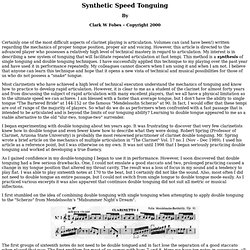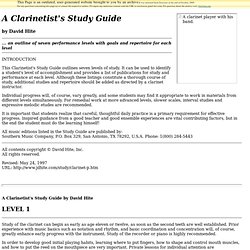

Clarinet Talk from Miami: Clarinet Exercises For Endurance. Tips on Breathing Breathing is at the very core of clarinet playing.

It is the foundation upon which everything rests – tone, technique, articulation, endurance, and musicality. Because of this is it is in our best interest to spend considerable time working on all aspects of breathing; including inhalation, exhalation, air quantity, air speed, and endurance. For this discussion I would like to focus on endurance, but first a quick refresher on proper breathing technique. To maximize our air capacity we must breath low with a relaxed and open throat. The pitch of your breath will sound high if you are breathing from the chest or throat.
Place the palm of your hand on your back, just above the waist and toward the side. Two Types of Endurance We need to work on two types of endurance; the first is 'rested endurance', which is the length of time you can hold a note with a rested, relaxed breath, such as the first breath of a piece. Any long tone exercise can be used to work on this. Dr D. Advanced clarinet technique: a new approach : from great orchestral literature.
Advanced Intonation Technique For Clarinets - John Gibson. Free Clarinet Sheet Music. Free Clarinet Sheet Music. Clarinet_techniques. Clarinet-Now. Free Saxophone Music Guide - Saxophone Sheet Music. Synthetic Speed Tonguing. Synthetic Speed Tonguing By Clark W Fobes – Copyright 2000 Certainly one of the most difficult aspects of clarinet playing is articulation.

Volumes can (and have been!) Written regarding the mechanics of proper tongue position, proper air and voicing. Most clarinetists who have achieved a high level of technical execution understand the mechanics of tonguing and know how to practice to develop rapid articulation. I began experimenting with double tonguing about ten years ago. As I gained confidence in my double-tonguing I began to use it in performance. I first stumbled on the idea of combining double tonguing with single tonguing when attempting to apply double tonguing to the "Scherzo" from Mendelssohn’s "Midsummer Night’s Dream". The first groups of sixteenth notes do not need to be double tongued and in fact lose the separation of a good staccato when played that way.
Further in the passage at bars 15 and 16 is a string of twelve notes in succession. Apropos to Mr. And then: Meri’s Musical Musings. The Clarinet Depot Articles Archive. Spring: Clarinet Warmup. Clarinet Warmup Robert S.

Spring Begin with long tones. This, as well as the rest of my warm up, is done with a metronome. Keeping things the same tempo everyday seems to help with overall consistency in performance. Play a chromatic scale in long tones. Next play the entire Klosé scale pattern, (page 123 in most Klosé books) in either the melodic, harmonic or natural form, ( vary these by day) at a tempo of quarter note = 60. I begin now to increase the tempo of the finger motion. I now begin warm up work on the tongue. I then introduce the single tongue with finger motion, again using the Klosé scales. I warm up my double and triple tongue next. I play them at 120, 144, 176, 208, 240, and 288. This is played at 160, 192, 224, 264, and 320. The entire warm up takes about 45 minutes to one hour if I do not have any reed work to do.
I hope this routine proves to be helpful to others. A Clarinetist's Study Guide by David Hite: Print Version. By David Hite ... an outline of seven performance levels with goals and repertoire for each level This Clarinetist's Study Guide outlines seven levels of study.

It can be used to identify a student's level of accomplishment and provides a list of publications for study and performance at each level. Although these listings constitute a thorough course of study, additional studies and repertoire should be added as directed by a clarinet instructor. Individual progress will, of course, vary greatly, and some students may find it appropriate to work in materials from different levels simultaneously. It is important that students realize that careful, thoughtful daily practice is a primary requirement for effective progress. All music editions listed in the Study Guide are published by: Southern Music Company, P.O.
Buzzing Reed- Breathing Clarinet & Classical Music for All. A 12 minute, fast-tonguing clarinet lesson, introducing various techniques and tricks for playing the most difficult clarinet passages in: Hector Berlioz “Nuits D’Été: L’Ile Inconnue”; and Felix Mendelssohn Scherzo, from his Incidental Music to the Midsummer Night’s Dream.

I demonstrate each passage using a combination of single and/or double-tonguing, with an occasional “hu” articulation. Using the “hu” articulation in certain spots is an unusual, but effective, way to help speed up and lighten single tonguing. These orchestral excerpts are among the most difficult classical music to perform well, and the Scherzo is required on virtually every clarinet audition list. Enjoy. (Below is a PDF of the difficult lick from Berlioz Nuit D’Été.
Berlios Nuite D’Ete, L’Ile Inconnu This YouTube video was posted by DJKKGaGa. Read more → We had a great live concert tonight as part of our AEP Pops series. Read more → Read more → Jazz-Improvisation-for-Classical-Musicians.